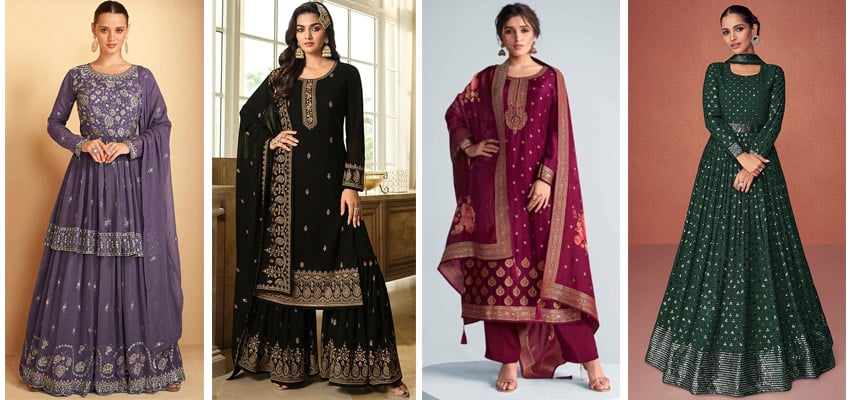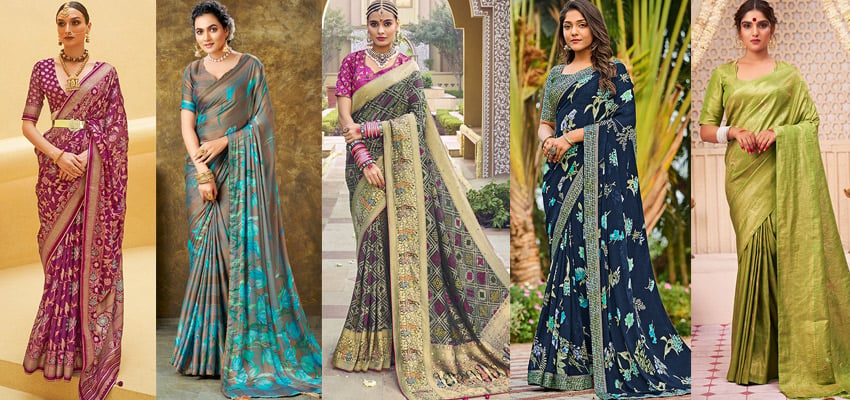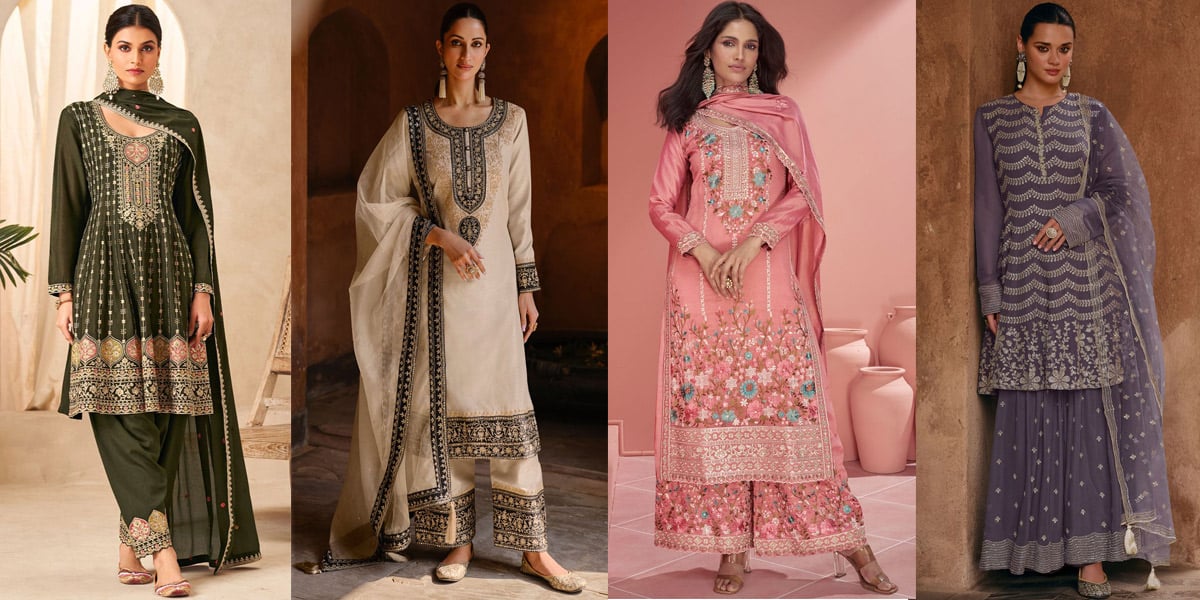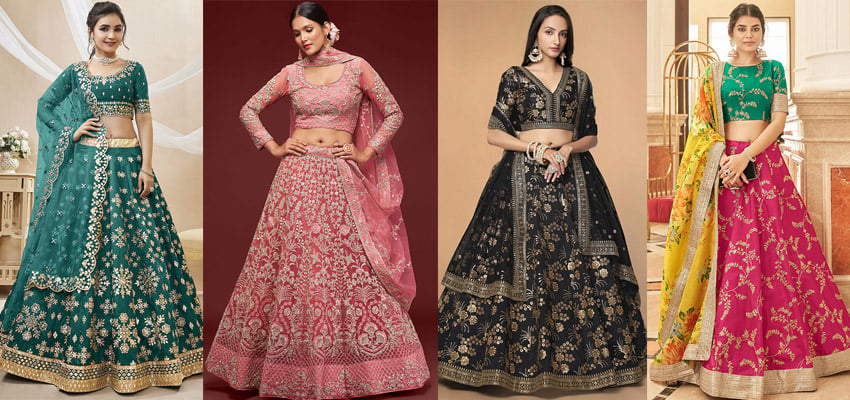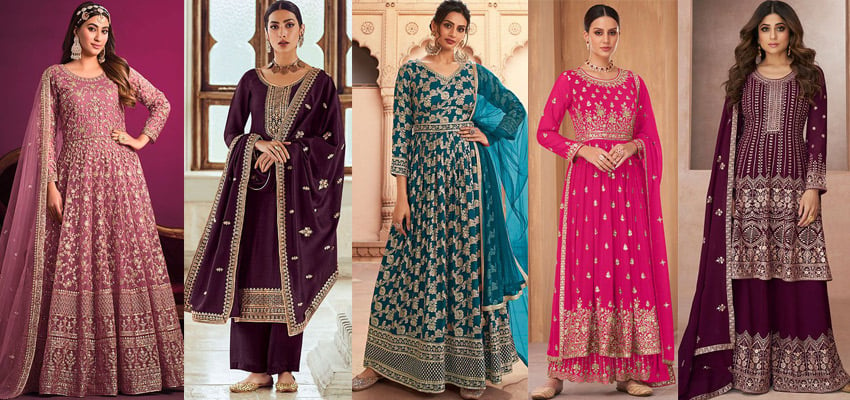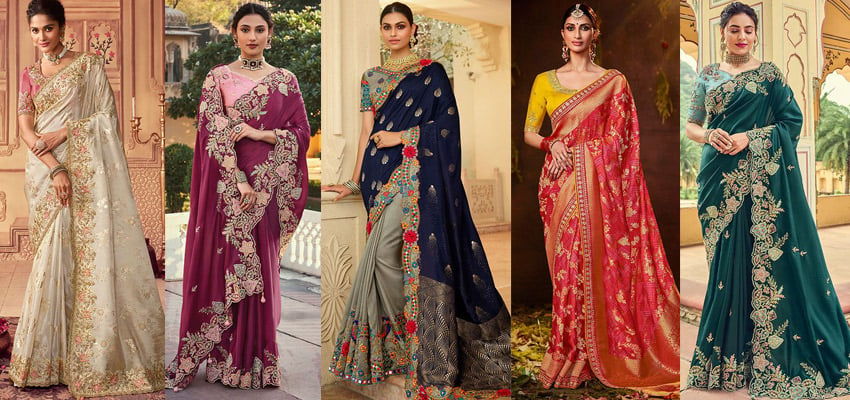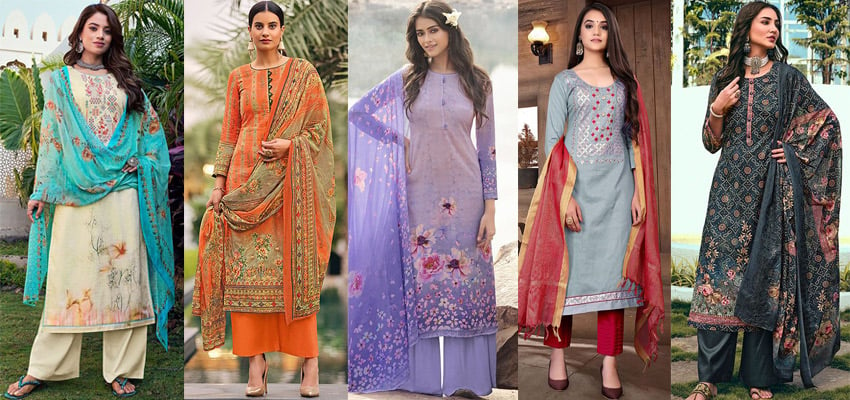The global market is at its peak for the Indian fashion sector! Indian ethnic attire is increasingly in demand, according to in-house fashion designers.
Due to the sizable Indian diaspora abroad, there is a continuing demand to produce chic yet distinctly Indian items. To serve the big audience that resides overseas ethnic Salwar Kameez outfits are exported in significant quantities. These stunning outfits are catching everyone's hearts for everything from casual wear to ethnic celebrations and even weddings!
Let us browse the newest ethnic salwar suit designs here in detail.
Common Aspects and Features of Ethnic Salwar Kameez Styles:
The term "Ethnic Wear" refers to any traditional Indian garment produced with Indian materials and patterns. Some of the significant facets are as follows:
- Ethnic salwar suits are created using materials that are purchased regionally, depending on their country of origin.
- They are available in a variety of cuts and styles to fit all age groups.
- Numerous traditional symbols are employed, including peacocks, elephants, horses, and even legendary scenarios.
- Salwar’s used for ethnic clothing are kept simple, such as the classic Churidar or the loose baggy style.
- A dupatta is a necessary accessory that goes with the suit and completes your attire look.
Top Types of Salwar Kameez Styles Available in the Indian Market
- Anarkali Suits
The style dates to the Mughal era and still dazzles the industry today. An Anarkali Salwar Kameez essentially consists of three separates:
- The Shirt (Kameez)
- The Bottom (Salwar)
- The Stole (dupatta)
The Anarkali Kameez style complements all body types. It is fitted at the top and flared like a frock as you go down. The bottom garment of the Anarkali Suit is typically fashioned of trapezoid-shaped cloth panels (Kali), which begin at the waist and give the shirt flare. Its lengthy pleats draw attention to the top while emphasizing the waist and hips. The dupatta, also known as the Stole, is a complementary loose piece of fabric that may be worn in many ways and completes the classic aesthetic of the suit.
- Churidar Suits
The churidar is a classic ethnic garment that has gained appeal throughout South Asia. A churidar suit is a variant of the salwar suit with a rich ancient history. The churidar pants fit below the knees with horizontal gathers close to the ankles. The churidar gets its name from the distinctive bunched-up folds resembling Indian bangles. These pants are typically longer than the leg and fit tightly below the knee. The churidar salwar kameez has a lovely fit and drapes a woman's shape well, highlighting the contours in a modest, alluring way.
The churidar is such a bottom wear that it has withstood the test of time and emerged as one of the most utilitarian outfits in the present day, where every product we leverage is about key functionalities and comfort of usage. Churidar can be worn with any form of kameez, including knee-length or flowing Anarkali, short kurtas or Kurtis, tunics, A-line, and asymmetrical Kurtis, among others.
- Patiala Suits
A type of salwar suit with roots in Patiala City, which is located in the northern part of Punjab, is well known as a Patiala suit. Just like a men's Pathani suit, this outfit has loose layers resembling a salwar and a long or knee-length top known as a kameez. However, different styles and cuts have been added to the garment over the years. The Patiala suit's distinctive feature is its pair of pants.
The Phulkari work, a traditional embroidery method used in Punjab, greatly adds eccentricity to Patiala suits made in that region. Punjabi Patiala suits are among those outfits that make you always appear classy and refined, regardless of the situation. They are exquisite Indian clothing pieces that are really lovely and adored by one and all.
- Sharara Suits
A pair of loose, pleated, or simple flared pants, called a Sharara, is worn with a skirt or lehenga. Another name for it is a flared palazzo. Sharara suits, which often have a flared, pleated bottom, have their origins in Islamic culture.
A Sharara salwar suit is a three-piece Indian ethnic outfit that consists of a kurta, which can be stitched in a variety of lengths. Still, short kurtas are preferred, a wide-legged bottom known as a Sharara that is fitted until the knees or lower, at which point a wide flare begins and extends to the floor, and a dupatta.
Sharara and Gharara are related, and the only thing that separates them is their radically dissimilar shapes. While they both resemble flared pants, Gharara have a more fitted silhouette from the waist to the knee. Above the knees is a band (traditionally called a gota), where the fabric is gathered to create an incredible flare all the way to the toes.
With its classic royal appearance, a Sharara or Gharara can amplify your desi style and make you stand out!
Categories of Salwar Kameez Found in the Market!
Salwar kameez patterns can be made in an infinite variety of fabrics, cuts, and embellishments. A few minor adjustments might provide a completely distinct salwar kameez pattern. The simplicity and all-around appeal of this clothing are what make it beautiful. These costumes are more adaptable, but other traditional clothes like the saree and lehenga choli are reserved for special occasions, formal occasions, or exclusive use.
- Occasional Wear Outfits
These outfits offer a graceful and stylish look, making this outfit suited for formal surroundings like the office, business conferences, and job interviews, as well as small celebrations such as wedding or birthday parties.
For instance, elaborate kashida embroidery as part of the neck designs for salwar kameez or pretty prints on the cuffs, neckline, and hem of the kurta gives a chic look to the wearer. The latest line of new salwar kameez designs, in fact, involves intricate and rich neck designs.
Zari, lace, and applique work, as well as Gota Patti designs, are some of the other most recent trends in salwar kameez neck designs. The beauty and grace of a woman's collarbone can be emphasized, which is why designers are so concerned with a salwar kameez neck design.
- Everyday Wear Outfits
For formal occasions, elaborate salwar kameez designs can be worn, while a more understated style can be worn every day. Block prints and floral prints are examples of modern, machine-generated designs, while Lucknowi Chikankari work and Punjabi Phulkari are examples of traditional, regionally distinct designs.
It is typically considered that the bodices of the kameez or the shalwar are entirely patterned or embroidered when one thinks of a shalwar kameez design. However, the most recent salwar suit designs only have embellishments on a small portion of the two pieces of clothing, leaving the rest of the outfit plain.
Latest Trends of Salwar Kameez for Everyone!
When it comes to salwar kameez patterns, there is a ton of possibilities available. Here are a few current salwar suit designs that never go out of style:
- Velvet Salwar Kameez
Recently, velvet salwar kameez patterns have dominated the runway. Velvet has an unequaled elegance, especially when it is enhanced by superb Zari work.
On and off the runway, numerous Bollywood and South Indian cinema actresses have been photographed donning various types of velvet salwar kameez.
- Chikankari Salwar Kameez
White salwar kameez is the ideal summer traditional attire for Indian women. One of India's oldest embroidery techniques, chikankari work was originally only done on white cotton. The color scheme changed as the work's style did.
However, artisans still favor working with pastels and light colors. Even if one has a green chikankari kurta, a white cotton bottom will make it stand out brilliantly.
- Punjabi Style Salwar Kameez
The salwar kameez's appeal is that it flatters a range of shapes and proportions. Consider one's shape before choosing a style when looking at salwar kameez design ideas. For instance, 3/4th sleeve kameez is best for ladies with larger arms as it gives better shape and adds to the overall style.
Conversely, Patiala salwar are better suited to women who have thin hips since these bottoms are designed to add more volume to that area.
Best Ways to Style Ethnic Salwar Kameez!
Follow this fashion advice if you are unsure about how to wear an ethnic salwar kameez outfit:
- Choose the appropriate fabric and color from the various ethnic salwar kameez patterns on the market based on the occasion.
- To create a unique style, you can choose to mix & match Kurta and salwar designs.
- Simple ethnic Kurtis can be glammed up by young girls by adorning them with chains and brooches.
- To look fashionable, tie your dupatta in a scarf-like fashion.
- To look like a Boho queen, try accessorizing with wooden beads or jewelry made of terracotta.
Key Takeaways
At YourDesignerWear, Indian ethnic dresses provide a free-wheeling stage for artistic expression. Our designers experiment with cuts, fabrics, and prints while maintaining the integrity of the original designs.
Adding layered jackets, palazzos, dhoti pants, cigarette pants, skirts, and even a basic ethnic salwar kameez gains a dramatic element. You may not have to repeat a design to two parties when so many possibilities are available on YourDesignerWear portal!


